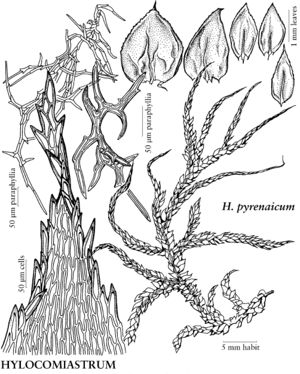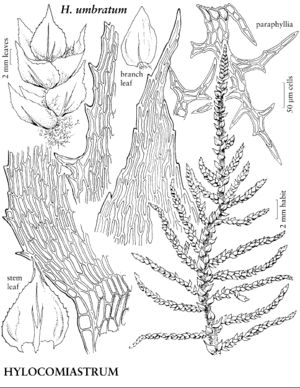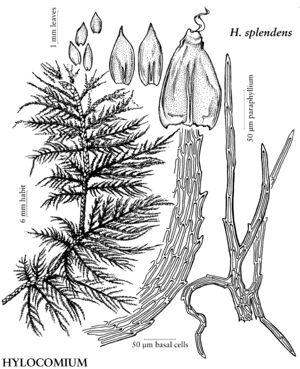Difference between revisions of "Hylocomiaceae"
FNA>Volume Importer |
FNA>Volume Importer |
||
| Line 108: | Line 108: | ||
|publication year= | |publication year= | ||
|special status= | |special status= | ||
| − | |source xml=https://jpend@bitbucket.org/aafc-mbb/fna-data-curation.git/src/ | + | |source xml=https://jpend@bitbucket.org/aafc-mbb/fna-data-curation.git/src/f6b125a955440c0872999024f038d74684f65921/coarse_grained_fna_xml/V28/V28_506.xml |
}}<!-- | }}<!-- | ||
-->[[Category:Treatment]] | -->[[Category:Treatment]] | ||
Revision as of 19:46, 24 September 2019
Plants in medium-sized to large wefts, often extensive sheets. Stems creeping to ascending or erect, sympodial or monopodial, irregularly branched to regularly pinnate, innovations often ascending-arching; paraphyllia sometimes present, branched, cells elongate; pseudoparaphyllia foliose; rhizoids few, at base of stems and apices of attenuate branches. Stem leaves very broadly ovate to lanceolate; margins serrate to serrulate, sometimes nearly entire; apex acuminate or sometimes acute to rounded; costa usually double, 1/4–2/3 leaf length, sometimes single or nearly ecostate; alar cells sometimes differentiated; medial laminal cells narrowly elliptic to linear-flexuose, prosenchymatous. Branch leaves usually smaller, narrower; margins more sharply toothed; costa stronger. Sexual condition dioicous. Seta elongate, smooth. Capsule usually inclined to horizontal; peristome double; exostome usually reticulate proximally, papillose distally; endostome basal membrane usually high, segments broad, perforate along keel by narrow slits or broadly elliptic gaps, cilia 1–4 (absent in Leptohymenium). Calyptra cucullate, smooth, naked. Spores spheric, finely papillose to nearly smooth.
Distribution
Nearly worldwide, primarily cool temperate to subarctic regions, extending to tropics in montane habitats.
Discussion
Genera 11, species 26 (7 genera, 12 species in the flora).
Hylocomiaceae include some of the largest pleurocarpous mosses of North America. Hylocomium splendens, Pleurozium schreberi, and Rhytidiadelphus triquetrus carpet vast areas of forest floor across the northern half of the continent. Because of their size, handsome appearance, and abundance, several species in this family are commercially harvested for decorative use. Since its original description, the family has been redefined several times (A. L. Andrews 1954; A. Noguchi 1972; J. R. Rohrer 1985b). Phylogenetic analyses based on ontogenetic, morphological, and anatomical evidence by Chiang T. Y. (2000) and L. Hedenäs (2004) suggested that the genera of Hylocomiaceae as defined by Rohrer (1985) comprise two or more clades, but the composition of the two main clades differs greatly between the two studies. Analysis of molecular data has so far been inconclusive (Hedenäs). Many of the genera are isolated phenetically, and clearly their cladistic relationships are debatable. The genera of Hylocomiaceae, as defined here, share various combinations of the following characters: sympodial growth, branched paraphyllia with elongate cells, differentiated stem and branch leaves, sharply serrate leaf margins, variable costae that are long and double or single and branched, prosenchymatous prorate laminal cells, reticulate exostome ornamentation, and endostome segments with broadly elliptic perforations.
Selected References
Lower Taxa
Illustrations
Key
| 1 | Stems with paraphyllia absent | > 2 |
| 1 | Stems with paraphyllia present | > 4 |
| 2 | Leaf apices rounded to obtuse, often appearing bluntly apiculate because of broadly incurved margins; margins entire except at apex. | Pleurozium |
| 2 | Leaf apices acuminate or occasionally acute; margins serrulate throughout or nearly so | > 3 |
| 3 | Stems 2-8 mm wide across leafy stem; stem leaves longer than 2 mm; bases not or slightly decurrent; capsules horizontal. | Rhytidiadelphus |
| 3 | Stems 1 mm wide across leafy stem; stem leaves shorter than 2 mm; bases narrowly decurrent; capsules erect. | Leptohymenium |
| 4 | Stems usually greater than 4 mm wide across leafy stem, irregularly and remotely branched, monopodial; stem leaves crowded, falcate-secund, usually longer than 3.5 mm. | Rhytidiopsis |
| 4 | Stems less than 4 mm wide across leafy stem, irregularly branched to pinnate, usually sympodial; stem leaves not crowded, heteromallous, usually shorter than 3.5 mm | > 5 |
| 5 | Stems regularly (1-)2-3-pinnate; stem leaves tightly appressed to erect; laminal cells occasionally prorulate. | Hylocomium |
| 5 | Stems remotely and irregularly branched to 1-3-pinnate; stem leaves erect to squarrose; laminal cells smooth | > 6 |
| 6 | Stem leaf bases not cordate-clasping; leaves strongly plicate (often obscuring costa); branch leaf costae single, double, or 2-fid, 1/2-3/4 leaf length. | Hylocomiastrum |
| 6 | Stem leaf bases broadly cordate-clasping; leaves moderately plicate (not obscuring costa); branch leaf costae double, 1/4 -1/2 leaf length. | Loeskeobryum |


